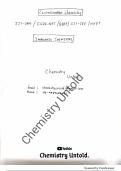Lecture notes
Mastering Coordination Chemistry: Principles, Reactions, and Applications"
- Module
- Institution
- Book
Coordination chemistry notes provide a comprehensive understanding of the fascinating field that explores the interactions between metal ions and surrounding ligands. These notes delve into the principles of coordination compounds, elucidating topics like bonding theories (such as valence bond and ...
[Show more]



